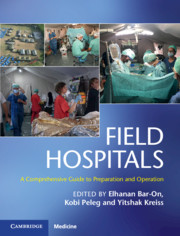Book contents
- Field Hospitals
- Field Hospitals
- Copyright page
- Contents
- Contributors
- Preface
- Section 1 History
- Section 2 Scenarios
- Section 3 Operational Considerations
- Chapter 6 Training and Accreditation
- Chapter 7 Personnel
- Chapter 8 Leading the Mission
- Chapter 9 Coordination and Organization of Medical Relief to Affected Areas
- Chapter 10 Field Hospital Logistics
- Chapter 11 Auxiliary Medical Services in a Field Hospital
- Chapter 12 Information and Communication Technologies in a Field Hospital
- Section 4 Clinical Considerations
- Section 5 Additional Contextual Considerations
- Index
- Plate Section (PDF Only)
- References
Chapter 8 - Leading the Mission
Organizational Structure and Operations
from Section 3 - Operational Considerations
Published online by Cambridge University Press: 09 January 2020
- Field Hospitals
- Field Hospitals
- Copyright page
- Contents
- Contributors
- Preface
- Section 1 History
- Section 2 Scenarios
- Section 3 Operational Considerations
- Chapter 6 Training and Accreditation
- Chapter 7 Personnel
- Chapter 8 Leading the Mission
- Chapter 9 Coordination and Organization of Medical Relief to Affected Areas
- Chapter 10 Field Hospital Logistics
- Chapter 11 Auxiliary Medical Services in a Field Hospital
- Chapter 12 Information and Communication Technologies in a Field Hospital
- Section 4 Clinical Considerations
- Section 5 Additional Contextual Considerations
- Index
- Plate Section (PDF Only)
- References
Summary
Effective administration of healthcare in an emergency setting, especially in field-hospital deployment where order must be established, needs assessed and limited resources allocated effectively, is considerably more complex than the regular patient–doctor interactions characteristic of routine times. Due to the complexity and uncertainty typical of such an environment, leadership is required not only by the field hospital staff but also by the affected public, which seeks leadership in those who are perceived to be the center of clinical service delivery.
This type of leadership demands organized command and control and practice of more than just basic leadership processes, and therefore requires, alongside the mission leader, a structured management and task-orientated chain of command.
For the hospital to operate effectively and independently, it is necessary to also define the organizational structure. The organizational structure discussed in this chapter is a model tested over the past three decades by the IDF Medical Corps hospital in numerous missions. This structure is generally similar to the basic structure of a small- to medium-scale hospital in routine times. At the same time, it allows more focused and simple managing processes required in non-routine scenarios such as emergencies or disasters.
Keywords
- Type
- Chapter
- Information
- Field HospitalsA Comprehensive Guide to Preparation and Operation, pp. 58 - 67Publisher: Cambridge University PressPrint publication year: 2020

